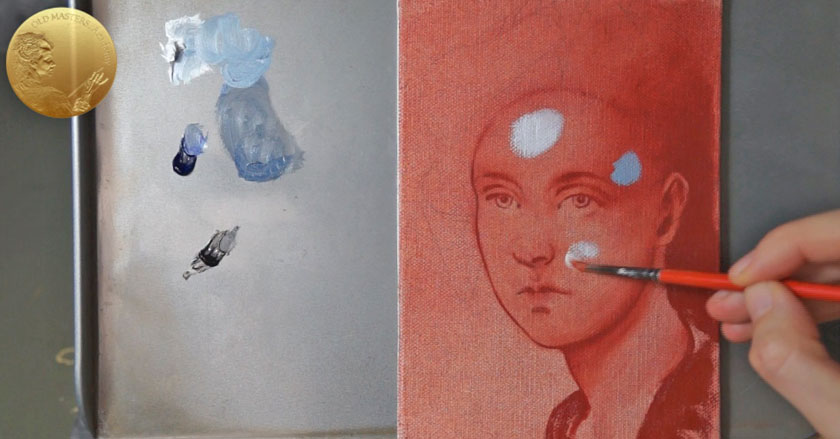Art Lesson 31, Part 5
Discover how to apply a Dead Color Underpainting
Learn how to paint like the Old Masters!
Old Masters Academy Online Course
Self-study, self-paced online video courseLifetime membershipOne-time payment: $487Enroll Now!Personal Tutoring online + Online Course
Unlimited tutoring by the Academy teachersLifetime membershipOne-time payment: $997Enroll Now!« Back to the Art Lessons List
Dead Color Underpainting
In this Video Lesson, we will see how to create a Dead Colors layer, which was an essential stage in the original Flemish Technique widely used in the Early Renaissance.
We will do a Dead Coloring over a completely dry Brush Sketch.

What Colors do we need? Titanium White, which is the most opaque of all Whites. Mars Black, which is also an opaque paint. We can make Dead Colors by just mixing the two White and Black paints. We also can extend our palette and add an Ultramarine (Blue Color) to it. You see, when White and Ultramarine are mixed, we get a light Blue Color. We can mute this Bluish dominance by adding Black into the mix.
At first, we should mix the Colors for Lights, Shades and Cast Shadows. The darker the mix we need, the more Blue and Black we add to the White. Then, we apply the mix samples on the canvas in the according areas. After that, we outline the silhouette and face features with a very dark Blue-Black mix.
Now, we begin spreading the shade Color in such a way to spread the paint evenly and thinly, but at the same time, densely. After that, we do the same for lights.
While the darker color mix is wet, it’s very simple to manipulate with a lighter mix. We apply the light Color densely and thinly in the most highlighted places; gradually, we make a very smooth transition by blending dark and light colors together. It’s important to have a thin layer of paint – the thicker the layer of paint is, the less control we have over the smooth transition.
This is how the Dead Colors Layer looks. However, what can we do to add extra volume to the painting surface? We wait till the Dead Layer dries entirely. Then, we take Titanium White and apply it densely in the highlighted areas; we rub the paint over the shaded areas in a thin spread, as we do when Scumbling. As a result, we have thickly applied the lights, but thinly applied the shades so that they look cloudy.
Dead Color Layer is a monochrome Underpainting, always made in cold colors; the lack of vivid flesh color gives them that term – “dead colors.” At this stage, the painting can represent the final look of a painting – the composition of the painting and main light-dark relations are established. Now, we have to wait till the paint dries and proceed with the Painting in Full Colors.
I have to note that already in 15th century, great artists started to modify this excessively complicated multi-layered Flemish method, making it easier by reducing in-between steps. The Dead Coloring was often skipped or made less precise and detailed.




